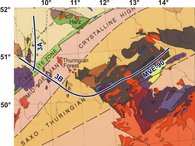Deep seismic investigations from the Hessian Depressian to the Bohemian Massif (Münchberg Complex-Vogtland-Erzgebirge)
The European Variscides, extending from the French Central Massif to the East European Platform, originated during the collision between Gondwana and Baltica in the Late Palaeozoic. Due to involvement of various crustal blocks in the orogenesis, the mountain belt is subdivided into distinct zones. The external fold-and-thrust belts of the Rhenohercynian (RH) and Saxothuringian (ST) as well as the predominantly crystalline body of the Moldanubian (MN) dominate the central European segment of the Variscides. Polyphase tectonic deformation, magmatism and metamorphic processes led to a complex interlinking between the units.
DEKORP 3/MVE 90 was a combined seismic survey investigating the Variscan structures of the Rhenohercynian and the Saxothuringian. Consisting of 3 seismic lines it starts in the Rhenohercynian Hessian Depression (DEKORP 3A), crosses the Saxothuringian Mid-German Crystalline High (DEKORP 3B) and runs parallel to the northern margin of the Moldanubian (MVE-90).
DEKORP 3/MVE-90 aimed
- to investigate and compare the structure and the transition zone between RH and ST, parallel to the DEKORP surveys of DEKORP 1 and DEKORP 2 (=> DEKORP 3B),
- to complete existing industry seismic profiles for a seismic image of deep crustal structure (=> DEKORP 3A),
- to study the complex geological pattern of the transition between ST and MN with respect to the geodynamic development (e.g. compressional or extensional) (=> MVE-90),
- to image the deep structures of the Münchberg Gneiss Complex (MGC) and the Eibenstock granite which coincide with gravity anomalies.
DEKORP 3/MVE-90 was a joint venture between the former two German Republics in 1990, shortly before reunification. The seismic survey consists of the 3 seismic lines DEKORP 3A, 3B and MVE-90 as well as short cross lines running almost perpendicularly to the main profiles (see location map).
Additional to the 2D seismic measurements several piggy back experiments were done:
- two CMP expanding spreads located over the gravity high of the Münchberg Gneiss Complex and the gravity low of the Eibenstock granite, designed to obtain information about the roots and depth extent of these structures,
- wide-angle seismic measurements (reversed and partly overlapping) along the MVE-90 profile,
- unreversed wide-angle seismic measurements parallel to line MVE-90 to obtain information on parts of the Eger Graben by undershooting it.
Experiments
DEKORP 3A:
The 145 km long DEKORP 3A line runs N-S within the Hessian Depression from the Solling Dome in the Rhenohercynian to the Vogelsberg Volcano of the Saxothuringian Mid-German Crystalline High. The middle part of the profile crosses the "Northern Phyllite Zone".
DEKORP 3B:
The 210 km long DEKORP 3B profile trends NW-SE and intersects DEKORP 3A in the Tertiary volcanic field within the "Northern Phyllite Zone". DEKORP 3B crosses the Hessian Depression of the Rhenohercynian, runs through the Rhön Tertiary volcanic province and the Mesozoic Franconian Basin to the Bohemian Massif. The line ends at the Franconian Line.
MVE-90:
The MVE-90 profile has a length of 208 km and crosses the Bohemian Massif from the Franconian Line to the Lausitz Massif. It intersects the allochtonous Münchberg Gneiss Complex, the Cambro-Ordovician South Vogtland Syncline as well as the Erzgebirge crystalline blocks.
long (start) lat (start) long (end) lat (end)
DEKORP 3A 9.44584 50.70248 9.573 51.83863
DEKORP 3B 9.01433 50.99485 14.49782 51.25678



